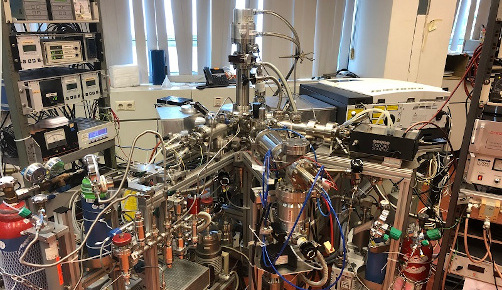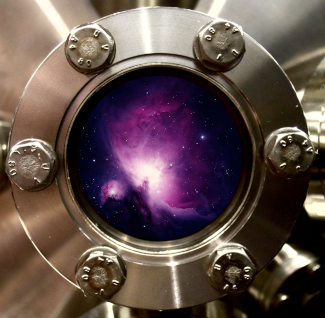In the Laboratory for Astrophysics, INTERCAT research will be performed with three cryogenic (10K) ultra-high vacuum setups – SURFRESIDE3, CRYOPAD2 and MATRI2CES. These experiments simulate the physical and chemical processes that govern the formation of larger and complex (organic) molecules, so called COMs, on icy dust grains under interstellar conditions. COMs are considered molecular building blocks of life.
It combines highly specialized research, covering a very large part of modern astronomy, with an active teaching program to more than 400 students. Fully embedded within the infrastructural settings of Leiden Observatory, is the LfA, the Laboratory for Astrophysics. Founded in 1975, it was the first of its kind: a laboratory fully dedicated to understand the physical processes that govern the cosmochemical evolution of matter in space. Today, the LfA is an internationally well recognized research facility focusing on research that explains how molecular complexity started in space and how this ultimately affected the origin of life.

SURFRESIDE3 [1,2] offers a tool to study pre-stellar chemistry, i.e. the chemistry taking place in dark and dense interstellar clouds, well before star and planet formation started. This cosmochemical phase is largely governed by non-energetic processes - atom addition and abstraction reactions – that provide pathways towards both very elementary molecules and larger COMs, e.g. starting from the hydrogenation of CO-ice and insertion of hydrocarbon radicals in the reaction network. The setup allows to bombard ices with H-, D-, N-, O- and C-atoms and sensitive diagnostic tools make it possible to study solid state molecule formation schemes and efficiencies for fully controlled laboratory conditions. In this way the interstellar formation of water [3] and methane [4] has been studied and it has been shown that larger COMs up to glycerol [5] are already formed on grains that form the material from which later planets are formed.

CRYOPAD2 and MATRI2CES [6,7] allow to study energetic processing of inter- and circumstellar ice analogues. Vacuum UV light is generated using special hydrogen discharge lamps to simulate interstellar radiation fields, simulating the conditions in translucent interstellar clouds or during the protostellar phase. This is the stage that a young stellar object is born and UV induced processes further determine the chemical composition of the protostellar disk and newly forming planets. The two setups are used to investigate which conditions are needed to form for example peptides and other COMs in space [6,8,9].
The work in Leiden provides quantitative information of the involved formation schemes and reaction rates. It helps in guiding upcoming observations with the James Webb Space Telescope that will search for COMs in ices in the interstellar medium. The research in Leiden also deals with grain gas phase interactions [10]. An important common goal within the INTERCAT collaboration is to understand the catalytic role of different grain surfaces onto the processes taking place; do different surfaces result in different astrochemical processes ? Such a question is of direct relevance for our understanding how solid state astrochemical processes ultimately set the framework within which life could start.
[1] A cryogenic ice setup to simulate carbon atom reactions in interstellar ices; D. Qasim, M.J.A. Witlox, G. Fedoseev, K.-J. Chuang, T. Banu, S.A. Krasnokutski, S. Ioppolo, J. Kastner, E.F. van Dishoeck, H. Linnartz, Rev. Sci. Instrum. 91 (2020) 054501.
[2] SURFRESIDE2: An ultrahigh vacuum system for the investigation of surface reaction routes of interstellar interest; S. Ioppolo, G. Fedoseev, T. Lamberts, C. Romanzin, H. Linnartz, Rev. Sci. Instrum. 84 (2013) 073112.
[3] Water formation at low temperatures by surface O2 hydrogenation II; the reaction network; H.M. Cuppen, S. Ioppolo, H. Linnartz, Phys. Chem. Chem. Phys. 12 (2010) 12077.
[4] Formation of glycerol through hydrogenation of CO ice under prestellar core conditions; G. Fedoseev, K.-J. Chuang, S. Ioppolo, D. Qasim, E.F. van Dishoeck, and H. Linnartz, Astrophys. J. 842 (2017) A52.
[5] An experimental study of the surface formation of methane in interstellar molecular clouds
; D. Qasim, G. Fedoseev, K.-J. Chuang, J. He, S. Ioppolo, E.F. van Dishoeck, H. Linnartz, Nature Astronomy, doi.org/10.1038/s41550-020-1054-y
[6] Formation rates of complex organics in UV irradiated CH3OH-rich ices I: Experiments; K.I. Oberg, R.T. Garrod, E.F. van Dishoeck, H. Linnartz, Astronomy Astrophysics 504 (2009) 891.
[7] Laser desorption time-of-flight mass spectrometry of UV photo-processed ices; D. Paardekooper, J.B. Bossa, K. Isokoski, H. Linnartz, Rev. Sci. Instrum. 85 (2014) 10450.
[8] The formation of peptide-like molecules on interstellar dust grains; N.F.W. Ligterink, J. Terwisscha van Scheltinga, V. Taquet, J.K. Jørgensen, S. Cazaux, E.F. van Dishoeck, H. Linnartz, MNRAS 480 (2018) 3628.
[9] Laser desorption time-of-flight mass spectrometry of UV photo-processed methanol ice, D.M. Paardekooper, J.-B. Bossa and H. Linnartz, Astronomy & Astrophysics 592 (2016) A67.
[10] Reactive desorption of CO hydrogenation products under cold pre-stellar core conditions; K.-J. Chuang, G. Fedoseev, D. Qasim, S. Ioppolo, E.F. van Dishoeck, H. Linnartz, Astrophys. J. 853 (2018) 102.